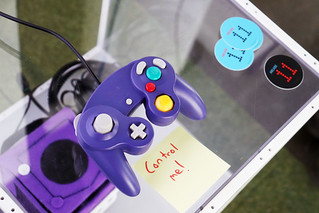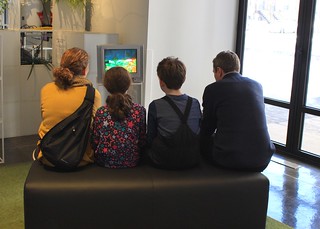Arcade11 2019
What is Arcade11?
Arcade11 is the annual indie and experimental videogame showcase of TAG (Technoculture Arts and Games) a facet of The Milieux Institute for Arts Culture and Technology. This year, the showcase took place March 4-8, in Concordia’s new interdisciplinary 4th Space and followed the theme of “research creation.” The exhibit consisted of a wide variety of games, custom hardware and projects by TAG member and Milieux, faculty and affiliates. There was also a series of live on-site interviews with participants (including one with me!) and playtesting of new games occurred throughout the week.
What did I do?
Besides running social media and helping organize the event, I displayed my in-progress research project on Super Smash Bros. Melee (SSBM) and its esports community. My exhibition consisted of a didactic panel which is an educational text about the work, with a brief overview of the community and its reliance on residual media.
 As well, we installed three systems playing SSBM: one original Gamecube connected to a CRT television via component cable; one soft-modded Wii connected to a CRT television via component cable; and one HDMI-modded Gamecube connected to an HDMI projector and displayed on a large screen facing the street.
As well, we installed three systems playing SSBM: one original Gamecube connected to a CRT television via component cable; one soft-modded Wii connected to a CRT television via component cable; and one HDMI-modded Gamecube connected to an HDMI projector and displayed on a large screen facing the street.
The last element of my space was my photo-essay. It outlines what esports looks like in the specific case of SSBM; a brief overview of signal processing; a comparison of SSBM to traditional fighting games; and original artwork of competitive spaces, all ported to a Raspberry Pi, housed in my handmade fuzzy Gamecube box. The Pi runs a program that allows viewers to scroll and zoom through the photo- essay with a Gamecube controller, so viewers gain a sense of SSBM’s materiality while they learn about its existence and protocols.
The essay was projected on the large screen next to the image from the HDMI Gamecube. Each of the four elements of my piece occupied a corner of the space, forming a cohesive unit that roughly emulates elements of the materiality of an SSBM tournament settings.
Catching Eyeballs at 4th Space
It’s worth noting that the 4th Space’s location is not only central, as it is attached to the Concordia library, but it also has windows for half of its walls, allowing the public to easily peer into the venue. My set-up occupied the entire window on De Maisonneuve, and the large projection of the HDMI Gamecube made it hard for pedestrians to miss. It was quite entertaining to see people pass by, stop and giggle or point at SSBM. The Smash Bros. franchise has been and continues to be well received by most people who have had any access to videogames at some point in their life.
Many observers would slow down by the window, some even stopping with their friends, presumably to share a memory or to explain their relationship to the game. Sometimes, seeing the game was enough to entice people enter the space to inquire about the event and my research. I expected this reaction, as the franchise has aged extremely well and has touched the lives of many people.
“I’m the best of all my friends at Smash” and Other Public Comments
In the venue, visitors continued to have positive reactions to the set-up. I heard many exclamations like “I love this game!” or “I haven’t played this since I was a kid!”. A few challengers dared to utter that “they are so good” or “better than all their friends” at SSBM. These are all common reactions I find when I discuss my affiliation with the SSBM community.
In my experience, the same people who make such claims often know little about the competitive context of SSBM. These players would often sit down for free-for-alls with items (complete opposite of tournament ruleset) and would select the common low-tier main of scrubs around the world: Kirby.
Many casual players play Kirby because he is slow, especially in the air, and easy to see. He also has multiple jumps, as opposed to the usual two, which makes recovering or returning to the stage very simple. However, he is arguably one of the worst characters in the game, especially in a competitive context. Kirby’s moveset is extremely slow and his moveset is much weaker compared to the rest of the cast. Numerous flaws in his movement options for ground and air make it hard for him to approach an opponent. This inability to approach is possibly his most fatal attribute.
Party Game and Family Fun
 There were almost always people congregating around the game. It was nice to see people of a variety of ages a interact with the game. There were a few instances where three generations of a family would play together, which is a sight I hadn’t seen before. The only similar instance I’ve seen is when children are too young to attend a tournament, so they come with a parent, guardian or older family member.
There were almost always people congregating around the game. It was nice to see people of a variety of ages a interact with the game. There were a few instances where three generations of a family would play together, which is a sight I hadn’t seen before. The only similar instance I’ve seen is when children are too young to attend a tournament, so they come with a parent, guardian or older family member.
As my essay explains, SSBM was conceived to be a party game. The competitive community for SSBM subverted this intention by studying the game, revealing its competitive potential and forming advanced and competitive techniques with the tools inherent to the game.
Arcade11 was the first time since before I joined the competitive SSBM scene that I have seen people playing the game in a way that abides by Nintendo’s intentions. This was a humbling experience, and serves as a reminder that every play style has its own ideology.
Smash players and other competitive video game communities are notorious for gatekeeping (deciding on community membership potential based on perceived right and wrong ways to play). This is especially the case for SSBM because of its speed, precision and its imperative to consult outside resources (see also Smashboards) to learn advanced techniques and community lore. This experience was a positive reminder that not everyone feels this demand for accuracy but all have a right to enjoy the game however they’d like.
Fuzzy Gamecube Imposter
 People were very impressed and excited by my photo-essay. I’d guess that about half the people who looked at it didn’t realize the fuzzy Gamecube was fake. In the context of the stimulating environment, and the three other set-ups for melee, many people were not able to decipher the imposter cube. Those who later realized were excited about the fake, and some expressed wanting to own one. This prompts me to research deeper about the attributes of cuteness that appeal to so many people.
People were very impressed and excited by my photo-essay. I’d guess that about half the people who looked at it didn’t realize the fuzzy Gamecube was fake. In the context of the stimulating environment, and the three other set-ups for melee, many people were not able to decipher the imposter cube. Those who later realized were excited about the fake, and some expressed wanting to own one. This prompts me to research deeper about the attributes of cuteness that appeal to so many people.
Nostalgia and Beloved Characters
SSBM is a visually approachable game because of its cast of commonly recognizable Nintendo characters. At the very least, most people recognize Mario or Link, and find some entry point that enables them to relate. One child even had audacity to yell “this game is SO old!”.
Of all the people I talked with and saw, only one person on Friday was playing with advanced techniques – a clear indicator of a relationship to the competitive scene. I was thrilled to see a “real” melee player at the event, and was even more excited after they asked me to play and then proceeded to quickly 2-0 them. This was the only time I really sat down to play during the event, besides with close friends who came to the arcade.
Often, I find playing or discussing the competitive levels of the game with casuals to be draining. They often ask repetitive questions and interrogate the validity of the scene in demeaning ways. It is not my desire to teach people how to play Melee. I was happy to discuss the scene and my research findings, but I do not have the energy to explain to random person #67 that Kirby is in-fact the worst character in the game, supported by years of analysis of the full cast. What I take from this is that it is easy to decipher those who have any remote competitive involvement with the game, simply by nature of how they talk about it. It is easy to locate casual players based on their perceptions of the game.
The public’s reaction to thinking the game in a competitive context almost mirrors the gatekeeping of many SSBM players. The public was averse to hearing truths about how the game is played now, as an esport, perhaps as a means of preserving their nostalgia or memories of the game. Regardless, I find that gatekeeping is inherit to a lot of videogame culture and can be effective in uniting gamers with common values, but destructive in ostracizing many potential players.
K thx bye
I was honoured and excited to have been a part of this special gaming event. Special thanks to Gina Hara for inviting me to be a part of Arcade11 and to Darren Wershler for the equipment from the Residual Media Depot and his magic HDMI skills. It is my pleasure to bring SSBM and my ongoing research into the public’s eyes, and doing my part to help the scene keep flourishing and growing.